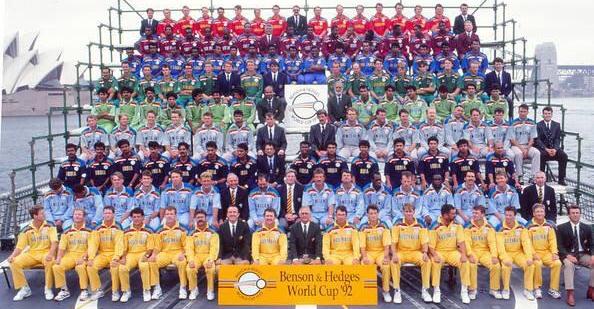Those Cricket World Cup formats
0One thing consistent in Cricket World Cup formats is change. This is the 11th incarnation of the competition, and there have been seven formats. Never have there been the same format used three times in succession. The only thing consistent has been the semi-final, final aspect; it’s how the Top Four have been decided where the tinkering has been.
This current format has been criticised for not having an edge around games in pool play, with the quarter finalists largely predictable. That is a bit of a myth really with seeding having an impact on later matches. There has been quite a range over the years though.
1975 and 1979: 8 teams, two pools of four
Those first two World Cups lasted .. a fortnight. A simple format at a time when the international cricket community was not that large. East Africa, a nebulous collection of expats were there in 75; Canada in 79 offered less than anything to follow.
1983 and 1987: 8 teams, two pools of four. Double pool play rounds
So this World Cup thing had legs; let’s expand it. Keeping the same format yet doubling the number of Group stages was, on reflection, a bit odd. The 1983 version was held at a good clip though; the event lasted 17 days. The 1987 tournament, with an identical format took a month
In both tournaments Run Rate was a factor.
1992: 9 teams, Round Robin
The Best Format EverTM
Nine team; each playing each other once, with the Top 4 straight through to a knock-out. To add even more glamour and novelty value, South Africa was included for the first time since before ODIs were invented. Adding more humour was an ageing Australian team scratching around at home, and a dream run from New Zealand.
It was the fairest format, bout could only work, just, with nine team taking part. Any more than that and it would start to drag a bit.
1996: 12 teams, two pools, quarter finals
The ICC’s first dabble into expansionism. The three team making their tournament debut were the Netherlands, Kenya (although East Africa was present in 1975) and UAE. The first two are not present in 2015, and the UAE are making only their second appearance.
Kenya did beat West Indies in a pool match so it seemed like widening the net was a good idea.
1999 and 2003. 12 teams, two pools followed by a Super 6
A format with a lot going for it that did not get the results it deserved. With three sides progressing from each group it meant that all matches between test playing nations had an element of the Sudden Death about them.
In 1999 Australia (of course) went on a go-slow when chasing down a small West Indies total in an intricate piece of mathematical skulduggery in an attempt to eliminate New Zealand, who had previously beaten the Evil Empire, so a favourable run-rate was carried forward. Or something like that. It was complicated, but it had its drama.
New Zealand had to chase down Scotland in 19 overs in its final pool match. A statistician’s wet dream
Bangladesh competed in the event for the first time in 1999, beat Pakistan in a match that had no effect on the final outcome* and got test status as a result.
The 2003 event was even crazier. Because pool games were held in Kenya and Zimbabwe games were forfeited, which really skewed and skewered the whole competition. The primary hosts were again eliminated early, and Kenya made the semi-finals. A shame really; that was not really the format’s fault and it was consigned to the recycling bin.
2007: 16 teams. Four pools of four and then a Super 8.
The year that the ICC thought it was FIFA, and came up with the mother of all formats. Including 16 teams was very super-sized and it was appropriate that this meant Bermuda, and Dwayne Leverock got to take part.
The format itself probably was not as bad as what followed indicated, but once India and Pakistan were eliminated in the first 10 days the air was taken out of the tournament.
The whole thing is best summarised here.
The final finished in the dark, which summed it up perfectly.
2011: 14 teams, two pools, quarter finals
Similar to the 1996 version with the reintroduction of Quarter Finals; the only difference being two extra teams and a 43 day event.
Like this time around the format was criticised because of perceived meaningless pool matches. The only exception to this was considered to be Bangladesh v West Indies in Dhaka. But the hosts were rolled for 58 so that was that.
England provided the entertainment in this cup. They beat table topping South Africa, tied with eventual champions India and lost to Ireland and the Netherlands. They would then get beaten in the Quarter final by Sri Lanka by a 10 wicket margin.

